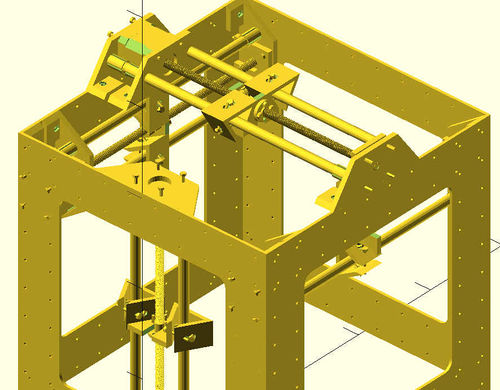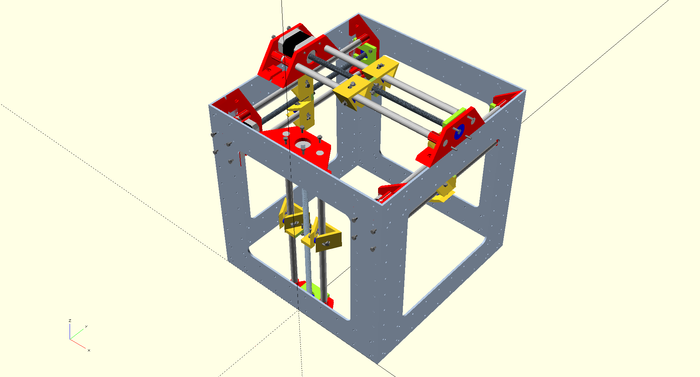D3D Development 2016
![]() Hint: Development from 2016. See 2017 development at D3D
Hint: Development from 2016. See 2017 development at D3D
See also Tobben Log
Development spreadsheet
Overview within the OSE Context
This is OSE's first experiment in creating a Distributive Enterprise. As the first step, Torbjorn Ludvigsen is working with OSE to deliver four 3D Printer build workshops as a self-sustaining revenue model - within the context of his Master's Thesis. Further steps are included at Roadmap#3D_Printer_Roadmap. To do this, we are building upon RepRap, and optimizing the build to allow for a low cost printer that can be built and run in a single day by novices, using OSE's Extreme Manufacturing techniques. Initial phases involve taking a kit 3D printer, and optimizing to reduce an average person's build AND shakedown time from 40 hours to 8 hours. The point is to cultivate a team of collaborative development on an enterprise where the economic reward structure is a highly replicable enterprise. The enterprise intends to use social production for building: 3D printers; products made with 3D printers such as cordless drills and polycarbonate greenhouse glazing panels; ancillary toolheads (laser engraving/cutting, milling, ceramic 3D printing, metal printing, etc); and ancillary equipment for plastics recycling (grinder, filament extruder, etc). The goal is to change culture by providing a rapid learning infrastructure for people interested in self-employment and right livelihood - by lowering barriers to such a transition. We are offering the support to non-makers in a transition to understanding the power to Build Yourself, and to Build Your World.
The key features of this project involve Extreme Collaboration by inviting open source and prorprietary stakeholders to contribute open content to the project. Since the scope is rapid, Open Source Product Development, our goal is to realize the proposition from the seminal paper, Achitecture of Partcipation: systems with more modular architectures, more divisible task structures, and/or more option value in the modules would attract more voluntary effort.
Most Recent Team Meeting
Jan 23, 2016:
Critical Path
Team Charter
Introduction
This project aims to be a proof of concept instance of a Distributive Enterprise focusing on 3D printers. It's similar to the RepRap project, but instead of focusing on creating and spreading machines (3D printers) this project focuses on people, the RepRappers. The idea is to achieve exponential increase in the number of RepRappers by simultaneously teaching RepRap and how to teach RepRap.
Chain reaction metaphor
The D3D stands for Distributive enterprise 3D printer. The "fusion" part is there because this project will try to bootstrap a kind of economical chain reaction:
- Instructor + Hardware + Plans + Participantsx → X (3D printer + New Potential Instructor)
This project will try to initiate a process where new instructors are formed who themselves obtain plans, hardware and participants to continue the process.
The → (workshop)
The "reaction" in this metaphor is a workshop. It will be designed into the smallest detail to facilitate reaction propagation. The design will be iteratively updated.
We (Tobben and Marcin) currently (6 Dec 2015) believe a one-day workshop has the best chance of propagating. This is because:
- Potential participants' time is limited. This will be squashed into peoples schedules
- Potential instructors needs economical incentives. Shorter workshops is more probable to generate a decent pay per hour
The Instructor
The first instructors will be OSE members. The Hardware, Plans and workshop will be designed to increase probability of a Participant → Instructor transition.
The Plans
Complete instructions and ready-made plans on how to host a workshop will be made as accessible as possible.
Making them good
Relevant data such as (build time, preparation time, etc) will be collected during every workshop. This data will be analyzed by the D3D project to facilitate plan design iterations.
Initial workshop plan will be guessed from various experience and beliefs.
Making them accessible
Features believed to increase accessibility include:
- Usage of rich media (video, sound, color, ...)
- Good language
- Good translations
- Wide publication
- All in one place (MOOC?)
Increasing accessibility easy. Doing it efficiently requires some consideration/experience.
The Participants
Potentially anyone. Make as few assumptions about participants as possible. Motivating people to become participants is a major part of the project.
The Hardware
The success of the RepRap project and the resulting increased availability of the RepRap hardware and information is the main reason why 3D printers are chosen as the first proof of concept Distributive Enterprise.
Making it good
Making the hardware as
- Generally useful
- Durable
- Easily repaired
- High quality
... as possible is a major part of the project.
This part of the project can build heavily on the results of the RepRap project- and community as well as other communities and available research on DIY 3D printers.
Making it accessible
Having a well engineered 3D printer will not lead to a workshop propagation unless the machine is
- Cheap
- Easy to use
- Easy to build
- Well documented
- Stylish
Business norms and science norms
D3D Fusion, as a DE, will eagerly train new competitors within its own production sector. Since there's no difference between "competitor" and "external collaborator" within OSHW enterprise, maybe we should call them something else? e-collegues?
On the market for selling prints, it will compete for customers as usual. During designing, coding and researching, it will benefit from other DEs' expertise, they will be collaborators.
This combination of roles is customary within the scientific community which relies on the following norms:
- Researchers are part time teachers
- Publish or perish (risk losing your reputation and/or job)
- Research must be replicable to gain trust
D3D Fusion applies similar norms to a RepRap business.
- Founder are part time teacher (makes an income through hosting workshops where he teaches his craft)
- All R&D progress published to the Internet
- The enterprise is replicable
There are currently no norms driving D3D Fusion into decision 1 but decision 2 follows norms within the Open Source Hardware community. Norm 3 is an extension of design norms within the RepRap community.
Part time teaching
Many companies teach their craft and succeed in competitive markets at the same time. Ideo is an example within design business that sells both designs and courses on designing[1][2][3], Lulzbot teaches by writing how-to guides[4][5], E3D teaches results of their R&D in public presentations[6]. The Ideo, Lulzbot and E3d enterprises prove that teaching your craft and selling your products simultaneously is economically sound (or at least doable).
Bootstrapping a market for DE workshops would give DE workers a special opportunities to work as part time teachers. This bootstrapping requires designing and testing a template, publishing it and supporting it with data.
Publish or Perish
The possibility to publish everything is already being used by current OSHW enterprises, such as Lulzbot[7] and E3d[8].
Replicability
This is where D3D Fusion will be the most different from current OSHW enterprises...
List of similar projects
Naming and Links
This is the front page of the overarching D3D Fusion Project. It has an over arching D3D Fusion Project Plan. There exist a sub-project called D3D Thesis, with its own D3D Thesis Project Plan. As a part of the D3D Thesis Project, the 3D printer design called D3D Printer and the design methodology called D3D Design Methodology are being developed. The development of the D3D Printer follows the D3D Design Methodology, and is being logged at D3D Printer Design Process. Description of the current D3D Printer Design is a dedicated developer-perspective wiki page.
List of Links
- 3D Printer Design Evolution
- D3D Distributive Enterprise
- Prusa i3 Build
- Follow progress of overall OSE 3D Printer Development at 3D Printer Log.
- D3D Fusion Project Plan
- D3D Thesis
- D3D Thesis Project Plan
- D3D Printer
- D3D Printer Git Repo
- D3D Design Methodology
- D3D Printer Design Process
- D3D Printer Design
- D3D Workshop Kit
- Prusa i3 Development
- 3D Printer Distributive Enterprise Log
- D3D Workshop Roadmap
- D3D Workshop Slogans

